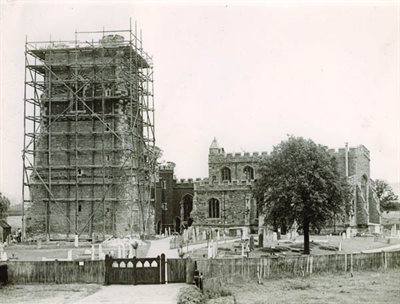Marston Moretaine Church Repairs and Alterations

The Church tower during repairs 1938-9 [X291/200/6]
Most of the structural history of the church can be found in detail in Bedfordshire Historical Record Society Volume number 77 of 1998 Bedfordshire Churches in the Nineteenth Century: Part II: Parishes H to R compiled by former County Archivist Chris Pickford from numerous sources, some held by Bedfordshire & Luton Archives & Records Service and some held elsewhere or published.
There are five bells in the tower which were all cast by Hugh Watts of Leicester in 1610 [extensive notes on the bells, also by Chris Pickford, can be found in CRT130MAR/17]. In 1617 the church was reported to be out of repair. Repairs to the roof were carried out in 1796 by John Carte, a plumber from Ampthill. In about 1800 the chancel was reroofed in slate instead of lead and the ceiling was erected. At some point before 1822, the interior was refitted with a new pulpit and desk, deal pews and children's pews at the west end. This work was done by Robert Feake Nixon, a Woburn builder. In an article on the church in the Northampton Mercury of 14th June 1845 ‘W.A.’ (John Martin, who wrote a series of articles on Bedfordshire churches) criticised this work; particularly the children's seats which blocked the west door. In 1827 Bossier had been similarly horrified by the damage that had been done to the screen and monuments; he also disliked the new pews.
Between 1823 and 1839 Archdeacon Bonney ordered a number of repairs. These included the thorough restoration of the tower and the repair of battlements on the north porch. In 1833-6 he ordered that cracks in the walls be investigated and the structure repaired. An old moat by the west end was found to be the cause of settlement and by 1848 the west end had been repaired and underpinned. A window in the north side had also been renewed.
In 1861 William Butterfield was asked to prepare plans for the restoration of the church. Work began with the nave which was finished in 1864, however a shortage funds prevented the whole scheme from being completed. The angels and carvings in the nave were restored and repainted in 1865 by the rector's daughter, Miss E. M. B. Tylecote. The restoration was finished in 1872-3 with work on the chancel, vestry and north aisle roof under George Gilbert Scott. The chancel fittings and pulpit date from this period. The external characteristics of the restoration are the distinctive ironwork on the doors and by the cast iron rainwater heads. The reredos was painted by Miss Tylecote. The official reopening took place on 8th October 1873. An extension to the churchyard was consecrated at the same time.
Later work included repairs to the tower in 1881 and the rehanging of the bells in 1900. The organ was added in 1895. In 1901 a stained glass window designed by Sir Edward Burne Jones and made by Morris & Co was installed in memory of Rev. J. Spicer Wood who died in 1893. The south aisle needed repairs in 1910 and in 1911 the Snagge monument was moved to a new position. In 1938-9 the tower was restored under the direction of Professor A.E. Richardson. The roof of the south aisle was repaired in 1952-3. The stained glass in the east window is by Hugh Easton and is a memorial to a former rector. The Victorian pews were removed in 1977 after the discovery of woodworm in the floor and the church is now seated with chairs.
Further information
P41/2/1: Records relating to the Church building are held under reference
P41/2/2: Records relating to the churchyard